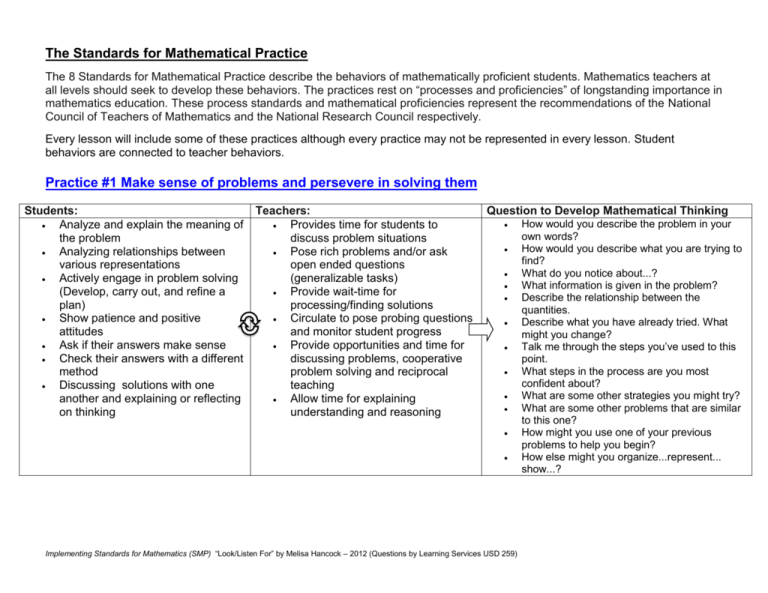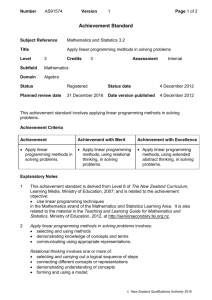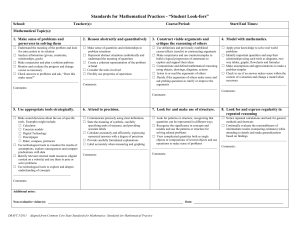Look/Listen For - Mathematical Practices
advertisement

The Standards for Mathematical Practice The 8 Standards for Mathematical Practice describe the behaviors of mathematically proficient students. Mathematics teachers at all levels should seek to develop these behaviors. The practices rest on “processes and proficiencies” of longstanding importance in mathematics education. These process standards and mathematical proficiencies represent the recommendations of the National Council of Teachers of Mathematics and the National Research Council respectively. Every lesson will include some of these practices although every practice may not be represented in every lesson. Student behaviors are connected to teacher behaviors. Practice #1 Make sense of problems and persevere in solving them Students: Analyze and explain the meaning of the problem Analyzing relationships between various representations Actively engage in problem solving (Develop, carry out, and refine a plan) Show patience and positive attitudes Ask if their answers make sense Check their answers with a different method Discussing solutions with one another and explaining or reflecting on thinking Teachers: Provides time for students to discuss problem situations Pose rich problems and/or ask open ended questions (generalizable tasks) Provide wait-time for processing/finding solutions Circulate to pose probing questions and monitor student progress Provide opportunities and time for discussing problems, cooperative problem solving and reciprocal teaching Allow time for explaining understanding and reasoning Question to Develop Mathematical Thinking Implementing Standards for Mathematics (SMP) “Look/Listen For” by Melisa Hancock – 2012 (Questions by Learning Services USD 259) How would you describe the problem in your own words? How would you describe what you are trying to find? What do you notice about...? What information is given in the problem? Describe the relationship between the quantities. Describe what you have already tried. What might you change? Talk me through the steps you’ve used to this point. What steps in the process are you most confident about? What are some other strategies you might try? What are some other problems that are similar to this one? How might you use one of your previous problems to help you begin? How else might you organize...represent... show...? Practice #2 Reason abstractly and quantitatively. Students: Represent a problem with symbols Explain their thinking Use numbers flexibly by applying properties of operations and place value Understand the meaning of quantities, not just how to compute Examine the reasonableness of their answers/calculations Teachers: Ask students to explain their thinking regardless of accuracy Highlight flexible use of numbers Facilitate discussion through guided questions and representations Accept varied solutions and representations (manipulative materials, drawings, online renderings) of problems Question to Develop Mathematical Thinking What do the numbers used in the problem represent? What is the relationship of the quantities? How is _______ related to ________? What is the relationship between ______and ______? What does_______mean to you? (e.g. symbol, quantity, diagram) What properties might we use to find a solution? How did you decide in this task that you needed to use...? Could we have used another operation or property to solve this task? Why or why not? Practice #3 Construct viable arguments and critique the reasoning of others Students: Understand and use prior learning in constructing arguments Make reasonable guesses to explore their ideas Justify solutions and approaches Listen to the reasoning of others, compare arguments, and decide if the arguments of others makes sense Ask clarifying and probing questions Teachers: Provide opportunities for students to listen to or read the conclusions and arguments of others Establish and facilitate a safe environment for discussion and risk taking is valued Ask clarifying and probing questions Avoid giving too much assistance (e.g., providing answers or procedures) Question to Develop Mathematical Thinking What mathematical evidence would support your solution? How can we be sure that...? / How could you prove that...? Will it still work if...? What were you considering when...? How did you decide to try that strategy? How did you test whether your approach worked? How did you decide what the problem was asking you to find? (What was unknown?) Did you try a method that did not work? Why didn’t it work? Would it ever work? Why or why not? What is the same and what is different about...? How could you demonstrate a counter-example? Implementing Standards for Mathematics (SMP) “Look/Listen For” by Melisa Hancock – 2012 (Questions by Learning Services USD 259) Practice #4 Model with mathematics Students: Analyze and model relationships mathematically (expression or equation) Represent mathematics to describe a situation either with an equation, diagram and interpret the results to draw conclusion Apply the mathematics they know to solve everyday problems Can determine if a model makes sense and/or needs modified Teachers: Question to Develop Mathematical Thinking Allow time for the process to What number model could you construct to take place (model, make represent the problem? graphs, write equations to What are some ways to represent the describe a situation, etc.) quantities? Provide meaningful, real What’s an equation or expression that world, authentic, performancematches the diagram..., number line.., based tasks (non traditional chart..., table..? problems) Where did you see one of the quantities in Provides contexts for students the task in your equation or expression? to apply mathematics learned Would it help to create a diagram, graph, table...? What are some ways to visually represent...? What formula might apply in this situation? Practice #5 Use appropriate tools strategically Students: Select and use tools strategically (and flexibly) to visualize, explore, and compare information Select and use instructional tools and resources to solve problems and deepen understanding (manipulatives, drawings, technological tools, graphs, mental estimation) Use external resources to solve problems Teachers: Make appropriate tools available for learning (calculators, concrete models, digital resources, pencil/paper, compass, protractor, etc.) Use appropriate tools instructionally Provide opportunities for students to use estimation and other mathematical knowledge to detect possible errors Make available external mathematics resources for students to use in solving problems Question to Develop Mathematical Thinking What mathematical tools could we use to visualize and represent the situation? What information do you have? What do you know that is not stated in the problem? What approach are you considering trying first? What estimate did you make for the solution? In this situation would it be helpful to use...a graph...,number line..., ruler..., diagram..., calculator..., manipulative? Why was it helpful to use...? What can using a ______ show us that _____may not? In what situations might it be more informative or helpful to use...? Implementing Standards for Mathematics (SMP) “Look/Listen For” by Melisa Hancock – 2012 (Questions by Learning Services USD 259) Practice #6 Attend to precision Students: Recognize the need for precision in response to a problem; clear and concise and uses appropriate mathematics vocabulary Calculate accurately and efficiently Use and explain meaning of symbols and specify units of measure Specify units, label answers to clarify correspondence with quantities in the problem Teachers: Use (and challenging students to use) mathematics vocabulary precisely and consistently Emphasizes the importance of precision in communication, uses clear definitions in discussions Question to Develop Mathematical Thinking What mathematical terms apply in this situation? How did you know your solution was reasonable? Explain how you might show that your solution answers the problem. Is there a more efficient strategy? How are you showing the meaning of the quantities? What symbols or mathematical notations are important in this problem? What mathematical language...,definitions..., properties can you use to explain...? How could you test your solution to see if it answers the problem? Practice #7 Look for and make use of structure Students: Look for, develop, and generalize relationships patterns and structure (properties, compose and decompose numbers) Understands WHY rules or properties “work” Apply reasonable thoughts about patterns and properties to new situations See complicated things as single objects or as being composed of several objects Teachers: Provide time for applying and discussing patterns, and structures that emerge in a problem solution Ask questions about the application of patterns and relationships Provide rich tasks that associate patterns with properties of operations and their relationships Question to Develop Mathematical Thinking What observations do you make about...? What do you notice when...? What parts of the problem might you eliminate..., simplify...? What patterns do you find in...? How do you know if something is a pattern? What ideas that we have learned before were useful in solving this problem? What are some other problems that are similar to this one? How does this relate to...? In what ways does this problem connect to other mathematical concepts? Implementing Standards for Mathematics (SMP) “Look/Listen For” by Melisa Hancock – 2012 (Questions by Learning Services USD 259) Practice #8 Look for and express regularity in repeated reasoning Students: Reason about varied strategies and methods for solving problems Look for methods and shortcuts in patterns and repeated calculations Understand the broader application of patterns and structure in similar situations Evaluate the reasonableness of results & solutions Teachers: Provide rich tasks and problems with patterns that require reasoning and sense making Encourage students to look for and discuss regularity in their reasoning Guide students in evaluating regularity and use their thinking to lead to general formulas Question to Develop Mathematical Thinking Will the same strategy work in other situations? Is this always true, sometimes true or never true? Use evidence to explain. How would we prove that...? What do you notice about...? What is the relationship between . . . . . and ……..? What does this tell us? What is happening in this situation? What would happen if...? Is there a mathematical rule for...? Explain the rule and where it came from What predictions or generalizations can this pattern support? What mathematical consistencies do you notice ? Implementing Standards for Mathematics (SMP) “Look/Listen For” by Melisa Hancock – 2012 (Questions by Learning Services USD 259)






